In 1996, Star Trek reached its 30th anniversary. Deep Space Nine celebrated this occasion with an episode called “Trials and Tribble-ations,” which was a direct crossover with “The Trouble with Tribbles.” With the DS9 Rewatch having reached that point, we’re celebrating by doing a redux of “Tribbles Week,” previously celebrated when the Star Trek Rewatch got to “The Trouble with Tribbles” back in 2010. We begin with a special rewatch of the episode that started it all…
“The Trouble with Tribbles”
Written by David Gerrold
Directed by Joseph Pevney
Season 2, Episode 13
Production episode 60342
Original air date: December 29, 1967
Stardate: 4523.3
Captain’s log: Kirk holds a briefing with Spock and Chekov. Since Chekov is all young and ensign-y, Kirk quizzes him on Deep Space Station K-7, to which they’re en route, and Sherman’s Planet, the closest Class-M world to the station. The planet is claimed by both the Klingon Empire and the Federation. Under the terms of the Organian Peace Treaty, whichever side can develop the planet most efficiently will be awarded the planet.
Uhura interrupts Chekov waxing rhapsodic about Russian history with a Code One Emergency—a disaster call—from K-7. However, they arrive at K-7 to find no Klingon ships, no evidence of a disaster. Kirk breaks radio silence to talk to Mr. Lurry, the manager of the station, who thumphers and says that maybe he should beam over. Kirk, livid, beams down with Spock. (Since neither Sulu nor Scotty are on the bridge, Kirk leaves no one in command in his and Spock’s absence, since we can’t have an ensign or a black woman in charge of a starship…)
Kirk points out to Lurry upon beaming over that misuse of the Code One Emergency frequency is a Federation offense, but it was actually Nilz Baris—the Federation Undersecretary for Agricultural Affairs—who issued the distress call. He needs Enterprise security to guard the tons of quadrotriticale they have on the station that is bound for Sherman’s Planet. It’s the only Earth grain that will grow on that world, so it’s key to the Federation winning the claim to it. Kirk therefore, very very very reluctantly, orders two security guards to report to Lurry, and also authorizes shore leave.
Uhura and Chekov go to the station bar, where a prospector named Cyrano Jones is trying to sell stuff to the bartender. While the latter is not at all interested in Spican flame gems or Antarean glow water, he is interested in tribbles. A small fuzzy creature that trills and purrs (and also eats the quadrotriticale that Kirk gave to Chekov), Uhura thinks it’s adorable, which is enough to convince the bartender to take them at six credits apiece (after considerable haggling). In gratitude, Jones lets Uhura have the sample tribble, which Jones insists will lead to tons of sales.
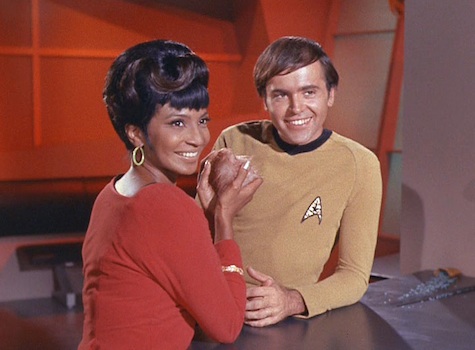
Back on the Enterprise, Admiral Fitzpatrick informs Kirk that the quadrotriticale is very important and he will render all aid necessary to Baris. Kirk isn’t exactly thrilled about that, and he’s even less thrilled when Uhura informs him that a Klingon ship has shown up. However, the ship’s captain and first officer, Koloth and Korax, are already in Lurry’s office, and it turns out that they just want shore leave also, which they’re entitled to by the treaty. Kirk agrees to allow Koloth to beam over only twelve of his people at a time, and he’ll assign one security guard for each Klingon.
Kirk and Spock hit the mess hall to find Uhura surrounded by people and tribbles. The one she got from Jones was apparently pregnant, as she now has a whole tableful of tribbles. McCoy takes one to check out and see what makes it tick, and various crew members take the others as well.
Baris then contacts Kirk, livid at all the Klingons. Talking to Baris gives Kirk a headache so he goes to sickbay, where McCoy’s single tribble has become eleven tribbles. Apparently 50% of their metabolism is given to reproduction. You feed a tribble, you get, not a fat tribble, as Kirk guesses, but a whole buncha hungry little tribbles.
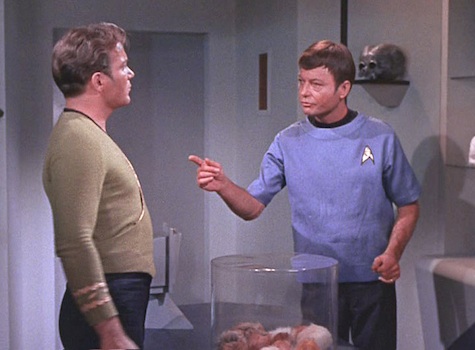
Kirk sends Scotty, Chekov, Freeman, and some others to K-7—Scotty doesn’t particularly want to go, but Kirk insists—and they head to the bar. Korax and a couple of other Klingons are sitting nearby. Jones comes in and tries to see if Scotty, Chekov, or Freeman wants a tribble—they really really don’t—and when he tries to hit up the Klingons, the tribble reacts violently. Jones has never seen them act like that before.
He goes to the bartender, who, it turns out, is awash in tribbles. However, Korax decides to take pity on Jones and give him part of his own drink. Korax then interrupts Scotty and Chekov’s discussion of whose drink is more manly, the former’s Scotch or the latter’s vodka, to talk trash about the Federation in general and Kirk and the Enterprise in particular. Scotty is able to follow Kirk’s instructions regarding not causing trouble, right up to the part where Korax insults the Enterprise herself, at which point he starts a big-ass bar fight. The bartender runs to fetch security and Jones takes advantage of his absence to grab himself a few free drinks.
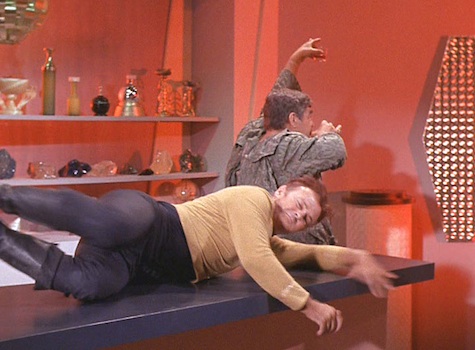
A half-dozen redshirts come in and break it up, leading to Kirk cancelling shore leave for both crews. He then lines up Scotty, Chekov, Freeman, and the rest to find out who threw the first punch. Nobody admits to it, but nobody admits who threw the first punch, showing very noble loyalty to Scotty. Kirk dismisses everyone except Scotty, who finally admits that he started the fight—but not after Kirk was insulted, but rather after the ship was insulted. Kirk is a little put out, but lets it go, confining Scotty to quarters—which makes him happy, as he can catch up on his technical journals.
The tribbles are overrunning the Enterprise. Sickbay is filled with them—prompting Spock to complain about how they serve no purpose—as is the bridge. Kirk actually sits on one. According to McCoy, they seem to be born pregnant, and they’ll be hip-deep in them soon. Kirk orders Uhura to have Lurry take Jones into custody, and also to clear the bridge of all the tribbles.
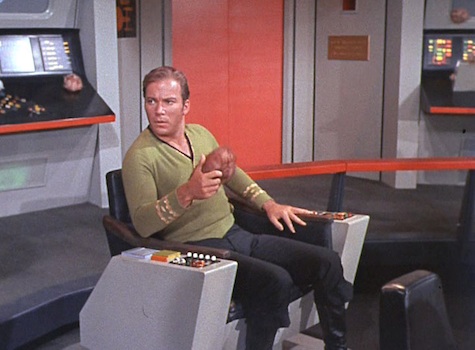
Jones, however, has done nothing wrong, and Kirk is forced to release him. Jones hands him a tribble on the way out. Baris then enters and complains that Kirk is taking this project lightly. Kirk insists that he takes the project very seriously—it’s Baris that he takes lightly. Baris also accuses Jones of being a Klingon spy, based in part on evidence compiled by his assistant, Arne Darvin. However, Spock has already checked into Jones, and there’s no proof that he’s a Klingon agent. Baris points out that he’s disrupted the station, and Kirk says you don’t need to be a Klingon agent in order to disrupt a station—all you need is a title.
Kirk and Spock head to the mess hall, which is now totally overrun by tribbles. Even the chicken sandwich and coffee he orders is all tribbles. Scotty confirms that they’ve gotten into the machinery, and Spock and Kirk realize that they may also get into the station’s machinery. They beam over and head to the storage compartments. Kirk orders the guard to open the compartment door, but it’s stuck. Eventually Kirk gets it open—
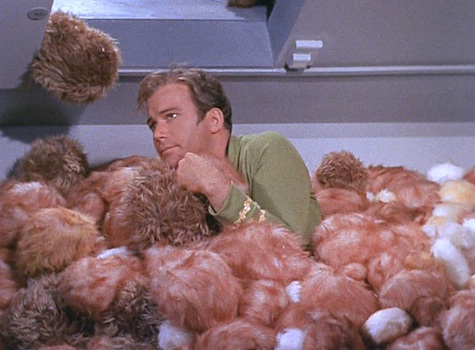
—and hundreds of tribbles cascade down upon him until he is shoulders-deep in gorged tribbles. They’ve eaten all the grain—and some of them are dead. McCoy confirms that, right after he announces that he’s figured out how to keep them from breeding: don’t feed them. McCoy takes a dead tribble for autopsy, while Kirk has Jones brought to Lurry’s office. Koloth and Korax are there also, insisting on an apology from Kirk to the Klingon High Command for the persecution of Klingon nationals. He also asks that the tribbles Jones is carrying be removed. The security guards do so, but as they pass Darvin, the tribbles go nuts in the same way they did around Korax in the bar.
Kirk takes two tribbles. He holds them in front of Koloth and Korax, and they spit and wail. They’re fine in front of Spock and Baris—but they also squeal in front of Darvin. McCoy, who entered in the midst of this, performs a medical exam that reveals that Darvin is a Klingon. McCoy also reports that the quadrotriticale was poisoned, which Darvin admits to rather than be subjected to the tribbles.
Kirk and Spock get Jones to agree to remove all the tribbles from K-7—starting with the ones in the bar that has buried the poor bartender, complete with one on his head—and then depart. Kirk is pleased to see that there are no tribbles on the bridge, either, and Scott explains that he beamed them to Koloth’s ship. “Where they’ll be no tribble at all.”
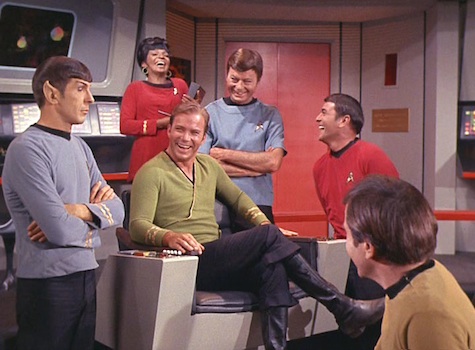
Fascinating: Spock claims to be immune to the trilling effects of the tribble, even as his speech slows down and he rhythmically pets the tribble. He also does his usual showing off, telling Baris that yeah, he does too know what quadrotriticale is, guessing the exact number of tribbles on the station (1,771,561), doing a full background check on Jones, and quoting the Bible at McCoy (“they toil not, neither do they spin”).
I’m a doctor, not an escalator: McCoy takes a potshot at Spock, telling him that he likes the tribbles more than him. Spock returns the favor by saying that the great thing about tribbles is that they don’t talk. Also McCoy pretty much saves the day by discovering that the quadrotriticale is poisoned and confirming Darvin’s Klingonicity.
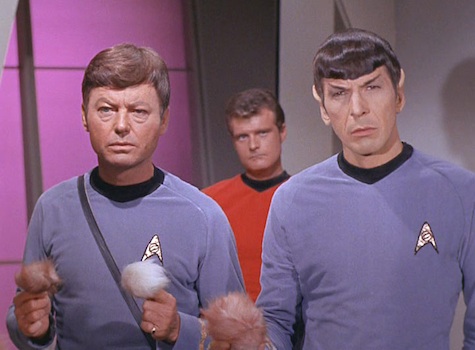
It’s a Russian invention: Chekov insists that the region they’re in was charted by a Russian astronomer named Ivan Burkhoff. Kirk and Spock correct him in that it was John Burke (the English form of Ivan Burkhoff) of the Royal Academy. The ensign also credits Scotch and quadrotriticale to the Russians.
Hailing frequencies open: The entire episode is basically Uhura’s fault, since her finding the tribble to be cute is what leads to them proliferating.
I cannot change the laws of physics! Scotty has to be put into a headlock to go on shore leave, as he’d much rather stay on the ship and read technical journals to relax. He then goes and starts a bar fight, which will probably keep Kirk from ever suggesting he go on shore leave ever again. (Given what happens in “Wolf in the Fold,” it’s probably generally for the best that Scotty never ever, under any circumstance, leave the ship.)
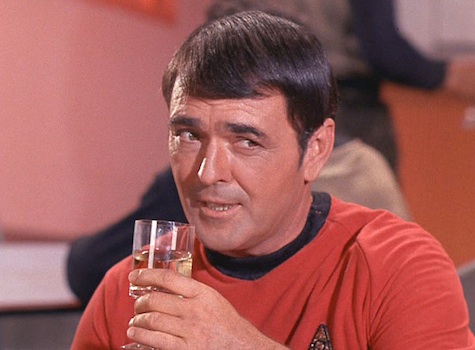
Channel open: “I was making a little joke, sir.”
“Extremely little, Ensign.”
Chekov trying to show that he has a sense of humor, and Spock reminding him that he has none.
Welcome aboard: William Schallert plays Baris; he’ll be seen again in DS9’s “Sanctuary” as a Bajoran musician. Charlie Brill makes the first of two appearances as Darvin; he’ll reprise the role in “Trials and Tribble-ations.” William Campbell returns as Koloth, having played Trelane in “The Squire of Gothos”; he’ll reprise the role of Koloth in DS9’s “Blood Oath.” Ed Reimers, best known as a pitchman for Allstate Insurance, plays Fitzpatrick. Stanley Adams makes the first of two appearances as Jones; he’ll reprise the role in voice form in “More Tribbles, More Troubles.” Michael Pataki plays Korax; he’ll return in TNG’s “Too Short a Season” as Karnas. Whit Bissell plays Lurry and Guy Raymond plays the bartender, while David L. Ross and Paul Baxley appeared in the background in their usual roles as Galloway and Freeman (the latter actually named in the lineup interrogation scene in the briefing room).
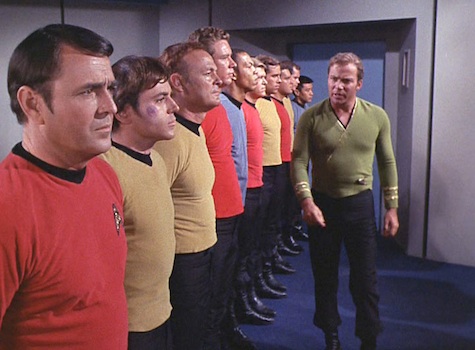
Trivial matters: The behind the scenes of this episode was provided by scripter David Gerrold in his two 1973 reference books The Trouble with Tribbles: The Birth, Sale, and Final Production of One Episode and The World of Star Trek. (The latter volume was revised and reprinted in 1984.) Gerrold would also co-write two more episodes of the original series (cowriting the story for “The Cloud Minders” and doing an uncredited rewrite of the script for “I, Mudd”), and wrote two episodes of the animated (“More Tribbles, More Troubles” and “BEM”). He was also heavily involved in the development of The Next Generation (and novelized the pilot episode “Encounter at Farpoint”), though he, along with several of his cohorts left the show due to disagreements with Gene Roddenberry in the first season.
This episode has the first reference to the Organian Peace Treaty, which was obviously signed after the Organians forced the Federation and the Klingons to end their nascent war in “Errand of Mercy.”
The Battle of Donatu V that Spock references as an early conflict between the Federation and the Klingons was fought 23 years earlier. It’s dramatized in the novel The Killing Blow by Kevin Ryan, part of the Errand of Vengeance trilogy.
The tribbles will return in “More Tribbles, More Troubles” and “Trials and Tribble-ations” (which we’ll cover tomorrow). The animated episode brings back the characters of Jones, Koloth, and Korax, though only Stanley Adams comes back to voice his character of Jones; Koloth and Korax were both voiced by James Doohan.
Adams would go on to co-write “The Mark of Gideon.”
Quadrotriticale is based on triticale, an actual hybrid grain. Quadrotriticale will be mentioned again in DS9’s “Business as Usual.”
Sherman’s Planet will be seen again—as a Federation planet—in the Starfleet Corps of Engineers eBook Oaths by Glenn Hauman, where they will suffer a horrible plague.
The infestation of tribbles in Koloth’s ship will lead to tribbles being declared an ecological menace in the Klingon Empire, as revealed by Worf to Odo in “Trials and Tribble-ations.” That episode also names Koloth’s ship as the I.K.S. Gr’oth. Koloth’s removal of the tribbles was shown in the short story “A Bad Day for Koloth” by David DeLee in Strange New Worlds 9, and he’ll look for vengeance on Jones in “More Tribbles, More Troubles.” Federation: The First 150 Years by David A. Goodman establishes that Koloth lead the armada that wiped the tribbles out.
Koloth and Kirk have obviously encountered each other before—one of those meetings was chronicled in the aforementioned Errand of Vengeance trilogy, and James Blish’s Spock Must Die! made reference to another conflict the pair had.
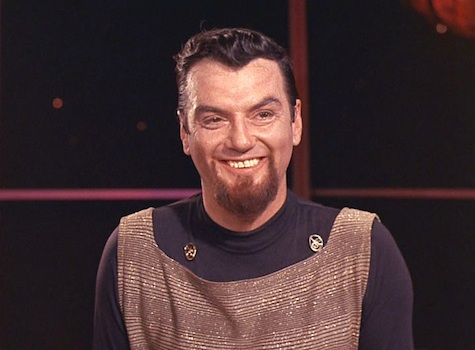
Koloth and Korax will go on to appear in a great deal of tie-in fiction, too numerous to list here, but a few of note besides those already listed include Dayton Ward’s In the Name of Honor; the backup story in DC’s Star Trek: The Next Generation Special #3, “Old Debts” by Kevin Ryan, Ken Save, & Shephard Hendrix (in which Koloth tries to get revenge against Scotty for beaming tribbles into his engine room); your humble rewatcher’s “The Unhappy Ones” in Seven Deadly Sins; and Margaret Wander Bonanno’s Dwellers in the Crucible.
Darvin’s backstory as to how he came to infiltrate the Federation government was chronicled in the second issue of the Blood Will Tell comic book miniseries written by Scott & David Tipton. That comic established that his real name was Gralmek.
Nilz Baris is the subject of a Citizen Kane-like story in the short novel Honor in the Night by Scott Pearson in the collection Myriad Universes: Shattered Light, which takes place in an alternate timeline where Darvin’s sabotage was never discovered, and the poisoned grain nearly killed everyone on Sherman’s Planet. Baris parlayed that defeat into an impressive career that included the Federation presidency.
Tribbles also show up again in Star Trek III: The Search for Spock, the Enterprise episode “The Breach,” the 2009 Star Trek, and Star Trek Into Darkness.
George Takei did not appear in this or several other second-season episodes due to his filming schedule for The Green Berets, in which he played Captain Nim opposite John Wayne.
To boldly go: “First, find Cyrano Jones, and second—close that door!” There’s almost no point in reviewing this episode, because it’s arguably Star Trek’s most popular hour, has many of its most quotable lines, has one of the franchise’s best visuals (Kirk being drowned in tribbles), and has never failed to be near the top of any best of Trek list.
But I do want to single out a couple of bits in this episode that get lost in the shuffle. For starters, while it’s generally considered a funny episode for the tribbles falling on Kirk and Kirk’s abuse of Baris (which really is a delight) and the tribbles being just bloody everywhere, there’s a lot of more subtle and brilliant comedy work here. The scenes between Stanley Adams and Guy Raymond are vaudeville gold. The business between Scotty and Chekov when the former hands the latter a Scotch without him realizing it, and Chekov gulps it before staring incredulously at the glass. Korax imitating Scotty’s drawl (“Yer right, I should”).

But perhaps the best performance here is William Shatner. We’re all aware of how good Shatner is at broad comedy, from his performances in “A Piece of the Action” and Star Trek IV: The Voyage Home, not to mention in places like Third Rock from the Sun, Free Enterprise, and his historic role as Denny Crane in The Practice and Boston Legal. This episode, however, reminds us of his incredible skill as a straight man. His exasperation, his deadpan, his reacting to Spock, to Jones, to Baris, to Scotty—it’s a masterpiece of comic timing, and he’s never once over the top.
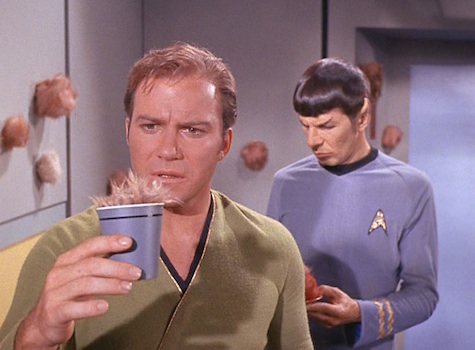
Everything came together perfectly in this episode: the writing, the directing, the acting. It seems almost churlish to point out the flaws, but I must mention two issues. One is that William Campbell is the most un-Klingon-like Klingon ever. It’s not surprising that when he reprised the role in “Blood Oath,” he pretty much had an entire personality makeover.
Also the scene between McCoy and Spock in sickbay—which was written by Gene L. Coon to add running time to the episode—is just pointless. It’s got too much of the mean-spirited part of their relationship without any of the affection.
But these are minor complaints—like getting the best steak ever and bitching because the parsley is slightly wilted. This is Star Trek at its finest.
Warp factor rating: 10
Keith R.A. DeCandido will be appearing at Balticon 48 this weekend. When he isn’t doing panels or readings or autographings, he’ll be in the dealer’s room at the Dark Quest Books table, peddling his books (and he’ll have a few copies of The Klingon Art of War for sale, too!). His schedule is here.










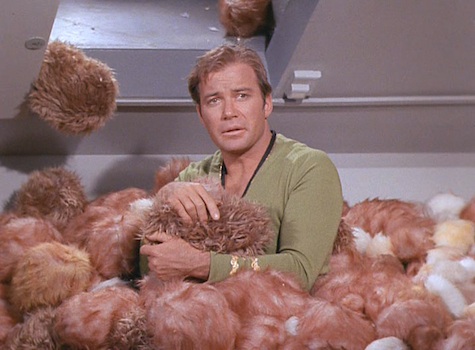
Admit it – the only reason for the new Tribbles week is because you wanted to enjoy this episode again. :-)
— Michael A. Burstein
mabfan: Actually it was so I could watch this and the DS9 episode back to back, which I’d never actually done. It was tremendous fun….
—Keith R.A. DeCandido
wait… Spock says the tribbles dont have mouths… how do they eat the grain? I have seen this episode a dozen times and never noticed that before.
great episode though… so many lines still crack me up even after all this time. definitely deserves the 10
Neuralnet: My bad. He didn’t say the tribbles don’t have mouths, he just said they didn’t talk. I’ve edited the post to fix my screwup. Apologies.
—KRAD
I actually rewatched this episode back-to-back with “Trials and Tribble-ations” the day before the Tribbles Week was announced. This one has always been my favorite TOS episode, though I do understand why many vote for City on the Edge of Forever. Sadly, neither of its sequels are QUITE as good, though DS9’s addition was a very good episode.
Also, Tribbles appeared (very briefly) in 2009’s Star Trek as well.
A technical nitpick: to the best of my recollection, it isn’t actually clear from the episode itself just how much of the quadrotriticale the tribbles managed to eat. On one hand, McCoy’s explanation of how the poison works — it causes the grain to become nutritionally inert — pretty strongly implies that the tribbles could very well have eaten it all. On the other, Kirk’s own line — “a warehouse full of grain, and they essentially starved to death” — is ambiguous as to whether or not any grain is left. (Personally, I always took that to mean that the tribbles succumbed before they could finish off the whole shipment.)
Mind you, the denouement is likewise ambiguous — it’s taken as given that the Federation will now win the claim to Sherman’s Planet, but there’s no mention of either a new shipment of quadrotriticale or some sort of antidote being used to treat whatever grain the tribbles might have left (an omission that would’ve taken one line of dialogue to fix).
But this is all pretty much handwaving, and we agree right down the line on the merits.
I’ve not read “A Bad Day for Koloth” from Strange New Worlds 9, but there’s a story in the original Strange New Worlds that would seem to be in a similar vein; “The Last Tribble” by Keith L. Davis, which covers Cyrano Jones’s painstaking removal of the tribbles from the station.
This episode is probably the perfect Star Trek comedy. Every beat and every nuance simply works. That scene where Cyrano Jones is weaving through the fight sneaking a drink, only to have the bartender take it from him is genius. And then it gets topped when he pulls a backup drink out of his pocket.
Apparently, the reason tribbles keep dropping on Kirk’s head throughout the scene is that there were a couple of props people in the back pitching tribbles through the hatch. Nobody told them to stop.
Also fascinating here is that David Gerrold was all of 19 when he sent this script in over the transom. He has said that the only reason he did it was that no one told him he couldn’t.
Koloth may be an un-Klingon Klingon, but maybe they sent their most diplomatic captain to a diplomacy task.
JohnCBunnell @6- I assumed that the Federation won by default because the Klingons were shown to have cheated and probably attempted murder.
Not much I can add except to agree that this is Star Trek at its finest.
Bobby
@8, I didn’t know that about the real-life explanation for the dropping Tribbles — though I do enjoy how DS9 gave an in-universe explanation during their episode.
@6: Actually, there was an exchange in the end scene about how Sherman’s Planet would “Get its quadrotriticale only a few weeks late” because Starfleet diverted a freighter. This is, of course, easily forgotten because it’s overshadowed by the “No tribble at all” bit.
Royal Academy, eh? That’s one talented painter.
Just have to add a comment for this post. Tribbles FTW!
KRAD and sps49: I remember watching this episode (on VHS) in college. My roommate commented, “these Klingons are such wimps compared to Worf!” Worf, of course, did become a diplomat. To be honest, I don’t think it has much to do with diplomatic captains, I think it has more to do with the fact that the writers hadn’t established much personality for the Klingons (and really didn’t until TNG, imho). William Campbell doesn’t help by giving his lines a rather Trelaine-esque reading, but it’s ultimately more the writing than the acting.
On an unrelated subject, the writers of a Trek role playing game suggested this concept: a Deep Space Nine arc on K-7.
Beside the great one-liners, I like the scene where the Tribbles reveal the disguised Klingon’s identity. Thanks for rewatching this one, KRAD!
Those of us who appreciate tribbles and other things TOS had a real treat at Arisia 14. There was a radio play of “The Trouble With Tribbles” in which all the characters were gender-reversed!
(More info on upcoming performances at http://huboftheuniverseproductions.com/events_tribbles.html )
Tribbles also appeared in Enterprise; Phlox kept a few on-hand as a food source for his other animal friends.
This was Star Trek at its best. One could quibble about details… (hey, I wonder if that is where the word ‘tribble’ came from?)
Oh, I’d say Darvin is an even un-Klingonier Klingon than Koloth. (Yes, I said “un-Klingonier.” Deal with it.) Look at how easily he caves and confesses the minute Kirk shoves a tribble at him.
Actually I think this episode is overrated. A lot of the humor and dialogue are just too broad and not very sophisticated, and there’s kind of a sense of trying too hard to get a laugh. Kirk’s rather juvenile insults toward Baris are particularly unfunny and forced.
And if you think about it, it’s making light of some very serious issues, such as the ecological impact of invasive species and an attempt to poison an entire colony. Not to mention its cavalier attitude toward the death of vast numbers of these animals it was playing up as adorable pets not long before. And what do you think is going to happen to the ones Scotty beamed over to the Klingon ship? It would’ve been kinder to beam them into space. It’s all kind of superficial in the end. (Although it’s better than “More Tribbles, More Troubles,” where Gerrold contrives a lame coincidence to justify telling essentially the same story with a few tweaks.)
@7: By my count, the ten Strange New Worlds volumes include nine tribble-related stories. They’re the second-most popular theme for SNW stories, exceeded only by Borg stories (11) and ahead of Q stories (8) and “City on the Edge of Forever”-related stories (8).
@19: Gerrold says in his book that he was going to call them fuzzies until the legal department pointed out the similarity to H. Beam Piper’s Little Fuzzy. Fortunately that also ruled out “furries,” which would’ve made the episode sound really weird to modern ears. He then typed up a list of dozens of nonsense words (including “shagbies,” “gollawogs,” “callahans,” “goonies,” “charlies,” “brazzies,” and “poofies”), and “tribbles” was the only one that was neither lame nor copyright-infringing. (Because of course nobody would ever use a name like “goonies”…) He wasn’t happy with the name until he realized the pun possibilities with “troubles” — although the title he wanted to use was “So You Think You’ve Got Tribbles–?” Gene Coon shot that down.
@20 – If the story behind the title we more well known, I wouldn’t be surprised if a future STD were called Tribbles, just for the opportunity to have an ad opening with “So, you think you’ve got Tribbles?”
Clearly Tor is getting in my head – the number of times that Uhura was called “little lady” in the first Tribble scene was as incredible as it was painfully awkward (even if both Jones and the Bartender appeared to be much older than her). I’m not sure
Definitely original Trek’s finest hour. I’m surprised Pevney was able to direct so many episodes in a row, and still be able to maintain this level of quality (then again, there were plenty of dreadful episodes on that show to make up for it).
I never understood why they decided to change the Klingons physiology in 1979. Was it to make their big screen appearance more impacting?
I often wonder if they were always designed to have the forehead ridges, but ended up not having them at all in the Original Series due to time and budget constraints. Then again, I guess Roddenberry wasn’t that concerned with in-universe continuity at that point.
I began watching Trek through the movies, long before I checked out the Original Series. Needless to say, it was jarring to see guys with moustaches and beards being called Klingons. They didn’t look alien. They looked like rebel hippies.
And what do you think is going to happen to the ones Scotty beamed over to the Klingon ship? It would’ve been kinder to beam them into space.
@20
That’s what I always thought, as well. Putting them amongst the Klingons is akin to a death sentence. And sure enough, Worf’s account of how the Klingons purged the Tribble threat, though humorous, proved me right.
@22: Actually Pevney directed every other episode (the odd-numbered ones) in the first 3/4 of season 2, except for “The Gamesters of Triskelion.” For most of that time, he was alternating with Marc Daniels.
The Klingons’ appearance, like so many other design elements, was changed in TMP because they now had the budget and resources to do the things Roddenberry wished he could’ve done in the original series. People often fail to realize that what ends up on TV usually doesn’t represent the creators’ ideal desires so much as what they had to settle for given limitations of time, money, network interference, and other real-world issues. A ton of what we saw in TOS was the result of budgetary compromises.
But no, the ridges weren’t designed for TOS and left unused. When “Errand of Mercy” was made, Fred Phillips and actor John Colicos pretty much improvised the Klingon makeup, going for a “space Mongol” look, a variant on the rather unfortunate makeup techniques used in ’60s TV to make white actors look like (supposed) Asians or other ethnicities. The prototype for the TMP Klingon design was the Kreeg, a mutant race in the post-apocalyptic future of Roddenberry’s failed 1974 pilot Planet Earth.
@23
That’s actually what I meant by in a row. Due to the alternating, there was pretty much no downtime between episodes. When you’re not shooting an episode, you’re prepping the next one. Marc Daniels is another I’m impressed was able to direct so many shows.
Also, the Kreeg head design not only seems to inspire the Klingon design, but also every other bumpy forehead alien design of the TNG era and onwards (including to a certain extent, the redesigned Romulans).
Just watched this episode and “Trials and Tribble-ations” back-to-back, and it makes for a wonderful double feature. I still laugh out loud watching this the way I did when I first saw this one as a kid. Wonderful episode always connected to wonderful memories.
@24: Well, I’m sure even freelance TV directors try to stay steadily employed — as soon as they finish with one episode on one show, they move right to doing another episode on another show. Getting a gig as a regular director on a single show would provide more job security, and would probably be easier because the director would already know the show and wouldn’t have to start from scratch on series after series.
Tribbles also show up in the Star Trek Online MMORPG, where different types of them have different in-game effects, and you can actually “breed” different types of them (by feeding them different kinds of foodstuffs).
The way they work is really rather amusing. If you leave a tribble in your character’s inventory with an item of food, a short time later you will have no item of food but an extra tribble in your inventory.
I don’t think I’ve actually seen this episode (I know!) although I did see Trials and Tribble-ations a few years ago. I have to admit, the episode doesn’t actually sound that funny to me. It seems like it might border on the type of hijinks everything-is-going-wrong humor that I never enjoyed, even as a child. The whole situation just seems very stressful and chaotic!
Also, the ending sounds kind of grueseome. I can’t imagine how horrible it would to be to simultaneously engorge and starve oneself to death. And what exactly are the Klingons going to do with those Tribbles????
@20 And of course there was “The Trouble with Borg Tribbles,” which should have gotten a special prize for combining both tribbles and the Borg!
What I want to know is: what are Tribbles like in the Mirror Mirror universe. If they are scary, the Sehlets must be terrifying.
@28: Well, you have to remember how slow-paced TOS episodes were in general (being from the 60’s). IMO, that counter-acts the “everything is going wrong everywhere” sense of chaos enough to make the episode enjoyable. As long as you take it as a comedy episode rather than thinking too hard about it (like the fate of the beamed tribbles at the end).
Come to think of it, I AM pretty impressed with the Klingons for accepting the stowaway tribbles as a Federation prank, rather than a Federation act of war. Although I guess embarking on a new genocidal war against tribbles was a good distraction.
1. Spock doesn’t guess the number of tribbles. (IIRC, Spock never guesses.) He calculates the number (11 to the 6th power) based on known data.
2. I’m surprised that any material had to be added to stretch the episode; Gerrold says (in cited book) that he had to cut ~17% of his script because he typed the standard number of script pages on a 12-pitch typewriter — but standard scripts were typed in 10-pitch. Where did you find that Coon had to write filler?
@32: 1. Right — if every tribble has a litter of ten once every twelve hours (so every one becomes eleven), then three days is six reproduction cycles, so it’s eleven to the sixth. Both Spock and Dax made the same simple calculation. But it’s still a very rough estimate, since there’s no guarantee that every litter would be exactly that size or come at exactly that interval, and it overlooks attrition due to accident. If anything, Spock had a tendency to be more precise than he should have been, implying certainty where there was room for error. It would’ve actually been better to say “approximately 1.8 million.”
2. Gerrold’s own book The Trouble With Tribbles, about the making of the episode, specifies that several scenes in the script were written by Coon. In particular, the scene with Spock and McCoy in the lab discussing tribble reproduction was written by Coon to restore some exposition from an earlier, otherwise unnecessary scene that had been cut. So it was more about structure than length, I think.
“We can’t have an Ensign in charge of a starship” or a Russian? Both Kirk and the bartender get drowned in Tribbles.